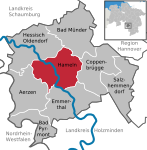Emmer (Weser)
Emmer basinLower Saxony river stubsNorth Rhine-Westphalia river stubsRivers of GermanyRivers of Lower Saxony ... and 2 more
Rivers of North Rhine-WestphaliaTributaries of the Weser

Emmer is a river of Lower Saxony and North Rhine-Westphalia, Germany. It flows into the Weser in Emmerthal.
Excerpt from the Wikipedia article Emmer (Weser) (License: CC BY-SA 3.0, Authors, Images).Emmer (Weser)
Emmer Weg,
Geographical coordinates (GPS) Address Nearby Places Show on map
Geographical coordinates (GPS)
| Latitude | Longitude |
|---|---|
| N 52.0568 ° | E 9.3813 ° |
Address
Emmer Weg
Emmer Weg
31860 , Kirchohsen
Lower Saxony, Germany
Open on Google Maps








